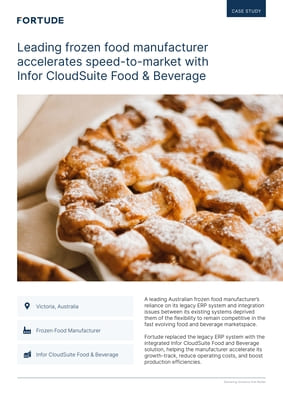Leading frozen food manufacturer accelerates speed-to-market with Infor CloudSuite Food & Beverage
Leading frozen food manufacturer accelerates speed-to-market with Infor CloudSuite Food & Beverage
An Australian frozen food manufacturer leveraged Fortude’s Application Managed Services to reduce YoY support tickets by 66%.
A leading Australian frozen food manufacturer’s reliance on its legacy ERP system and integration issues between its existing systems deprived them of the flexibility to remain competitive in the fast evolving food and beverage marketspace.
Fortude replaced the legacy ERP system with the integrated Infor CloudSuite Food and Beverage solution, helping the manufacturer accelerate its growth-track, reduce operating costs, and boost production efficiencies.
Challenges
- Legacy ERP was implemented to cover a very basic scope and didn’t provide the manufacturer with full ERP functionality.
- Outdated tech platform was resource intensive and incurred a high maintenance cost.
- Integrations were limited and done on an outdated platform with no support in Australia.
- Informal processes adopted with no documentation for on-boarding new users.
- Urgently needed a robust solution with standardized processes to roll out to newly acquired business units.
Solution
- Seamlessly integrated Infor CloudSuite F&B across multiple entities in Australia and New Zealand, supporting over 200 users.
- The latest user experience enhancements provided by the Infor OS stack facilitated many efficiency improvements such as Screen Personalizations, Automated Document Archiving, and User Collaboration with Automated Workflows and Notifications.
- Implemented Infor Factory Track mobile warehouse and production reporting solutions, helped to deliver improvements in efficiency through scan-based transaction recording.
- Standard implementation templates helped establish a framework for rolling out Infor CloudSuite F&B and integrations to new business units and factory locations, with ease and fewer configurations.
- Standardized integrations built on a modern middlewear to improve speed and accuracy of data exchange and reporting.
- Multiple customer EDI systems (via the GXS BizManager)
- Demand forecasting, pricing, and promotion planning
- Robotic palletizer
- Production tracking
- Third-party logistics (3PL) systems
- Maintenance management system
- Banking systems
- Financial reporting
- Business intelligence
- Automation of high-volume transactions for general journal posting, customer statement upload tool and automatic matching of receipts.
ERP Implementation Impact
- Enabled the management of business entities across Australia, a new subsidiary in New Zealand, and multiple manufacturing plants.
- Repeatable implementation and training processes and templates for quick onboarding of users and rollout to new business units.
- Standardized data and metrics across entities, enabled quicker reporting and consolidation of information.
- The real-time view of orders, inventory, production, and financials, empowered users to make business decisions quickly.
- Enabled complete traceability of information from raw material source upto finished product sales.
- Improved customer and regulatory compliance through easy reporting and analytics.
- The cloud-based software as a service (SaaS) model and Fortude’s application support services reduced admin and infrastructure costs.
- Seamless transition of support to Fortude Application Managed Services.
Application Managed Services Impact
- Fortude’s Application Managed Services support reduced admin and infrastructure costs.
- Helped stabilize and integrate finance processes across entities in Australia and New Zealand.
- Tracked and eliminated finance issues by correcting processes and actively providing recommendations.
- Improved ticket trends and enhancements of business processes to better align with business goals.
- Continuous enhancements for existing developments and introducing new controls or integrations to align with business strategic direction
- Implementation of Standard Operating Procedures helped create a framework for finance functions.
Download Case Study

Subscribe to our blog to know all the things we do
